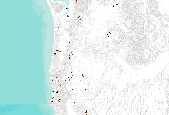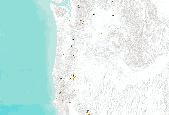Filters: Tags: demographics (X)
86 results (151ms)|
Filters
Contacts
(Less)
|

The Institute for Bird Populations (IBP) coordinates the Monitoring Avian Productivity and Survivorship (MAPS) Program to assess and monitor the vital rates and population dynamics of North American landbirds. The MAPS Program utilizes a standardized constant-effort mist netting and banding protocol (DeSante et al. 2010) at a continent-wide network of monitoring stations. Each summer dedicated volunteers operate bird-banding stations to collect data on individual "birds-in-the-hand" representing over 200 species. Analyses of MAPS data provide critical information relating to the ecology, conservation, and management of North American landbird populations and the factors responsible for changes in their populations....
U.S. Counties (Generalized) represents the counties of the United States in the 50 states and the District of Columbia. These data were reprojected to USA_Contiguous_Albers_Equal_Area_Conic_USGS_version and clipped to the MAR REA boundary.
Population range for each city/town. pop_5: 100,001 -1,000,000 U.S. Populated Place Points represents populated places that include census designated places, consolidated cities, and incorporated places within United States identified by the U.S. Census Bureau.
U.S. Cities represents locations for cities within United States with populations of 10,000 or greater (based on Census 2000 figures), all state capitals, and the national capital.
This EnviroAtlas web service supports research and online mapping activities related to EnviroAtlas (https://www.epa.gov/enviroatlas). The Clean and Plentiful Water category in this web service includes layers illustrating the ecosystems and natural resources that filter and regulate water, the need or demand for clean and plentiful water, the impacts associated with water quality, and factors that place stress on water quality and supply. EnviroAtlas allows the user to interact with a web-based, easy-to-use, mapping application to view and analyze multiple ecosystem services for the conterminous United States. Additional descriptive information about each attribute in this web service is located within each web...
A limited amount of valid scientific information about global climate change and its detrimental impacts has reached the public and exerted a positive impact on the public policy process or future planning for adaptation and mitigation. This project was designed to address this limitation by bringing together expertise in the social and communication sciences from targeted academic institutions affiliated with the Department of the Interior’s Climate Science Centers (CSCs) through a workshop. The project team brought together expertise in the social and communication sciences from targeted academic institutions, particularly experts and scholars who are affiliated with the nation’s CSCs, by means of an invited...
Categories: Project;
Types: Map Service,
OGC WFS Layer,
OGC WMS Layer,
OGC WMS Service;
Tags: 2012,
CASC,
Completed,
FY 2012,
Projects by Region,
This EnviroAtlas web service supports research and online mapping activities related to EnviroAtlas (https://www.epa.gov/enviroatlas). The Food, Fuel, and Materials category in this web service includes layers illustrating the ecosystems and natural resources that provide or support the production of food, fuel, or other materials, the need or demand for these items, the impacts associated with their presence and accessibility, and factors that place stress on the natural environment's capability to provide these benefits. EnviroAtlas allows the user to interact with a web-based, easy-to-use, mapping application to view and analyze multiple ecosystem services for the conterminous United States. Additional descriptive...
2000 Census blocks were analgamated and then joined to 2000 census demographics. All files were downloaded from the ESRI website: http://www.esri.com/data/download/census2000_tigerline/index.html. The original shapefile was reprojected from GCS_1983 to UTM_NAD 83 Zone 13N so that each census block's area could be calculated in square meters. A formula from the ArcMap Help was used in each census block's area calculation. Square meters were convereted to square miles, and finally people per square mile was computed.

The Institute for Bird Populations (IBP) coordinates the Monitoring Avian Productivity and Survivorship (MAPS) Program to assess and monitor the vital rates and population dynamics of North American landbirds. The MAPS Program utilizes a standardized constant-effort mist netting and banding protocol (DeSante et al. 2010) at a continent-wide network of monitoring stations. Each summer dedicated volunteers operate bird-banding stations to collect data on individual "birds-in-the-hand" representing over 200 species. Analyses of MAPS data provide critical information relating to the ecology, conservation, and management of North American landbird populations and the factors responsible for changes in their populations....

The Institute for Bird Populations (IBP) coordinates the Monitoring Avian Productivity and Survivorship (MAPS) Program to assess and monitor the vital rates and population dynamics of North American landbirds. The MAPS Program utilizes a standardized constant-effort mist netting and banding protocol (DeSante et al. 2010) at a continent-wide network of monitoring stations. Each summer dedicated volunteers operate bird-banding stations to collect data on individual "birds-in-the-hand" representing over 200 species. Analyses of MAPS data provide critical information relating to the ecology, conservation, and management of North American landbird populations and the factors responsible for changes in their populations.
Tribal census tracts are small, relatively permanent statistical subdivisions of a federally recognized American Indian reservation and/or off-reservation trust land. The optimum size for a tribal census tract is 2,500 people; it must contain a minimum of 1,000 people. The difference between a tribal census tract and a nontribal census tract is in the hierarchical presentation of the data. A tribal census tract is part of the American Indian hierarchy; that is, the tribal census tract is within a federally recognized American Indian reservation and/or off-reservation trust land.
Categories: Data;
Types: Downloadable;
Tags: Census,
Federal Government,
US Census,
demographics,
society
Wyoming state senate districts with demographic data.
Categories: Data;
Types: Downloadable;
Tags: Census,
Federal Government,
US Census,
boundaries,
demographics,
U.S. Counties represents the counties of the United States in the states of Arizona, California, Colorado, New Mexico, Nevada, and Utah.
Population range for each city/town. pop_4: 10,001 - 100,000 U.S. Populated Place Points represents populated places that include census designated places, consolidated cities, and incorporated places within United States identified by the U.S. Census Bureau.
The Northwest Climate Conference (formerly called the Pacific Northwest Climate Science Conference) is the premier climate science event for the region, providing a forum for researchers and practitioners to share scientific results and discuss challenges and solutions related to the impacts of climate change on people, natural resources, and infrastructure in the Northwest. Conference participants include policy- and decision-makers, resource managers, and scientists from academia, public agencies, sovereign tribal nations, non-governmental organizations, and the private sector. More information can be found at the conference website: http://pnwclimateconference.org. The Second Annual Pacific Northwest Climate...
Categories: Project;
Types: Map Service,
OGC WFS Layer,
OGC WMS Layer,
OGC WMS Service;
Tags: 2011,
CASC,
Climate Change,
Completed,
Northwest,

The Institute for Bird Populations (IBP) coordinates the Monitoring Avian Productivity and Survivorship (MAPS) Program to assess and monitor the vital rates and population dynamics of North American landbirds. The MAPS Program utilizes a standardized constant-effort mist netting and banding protocol (DeSante et al. 2010) at a continent-wide network of monitoring stations. Each summer dedicated volunteers operate bird-banding stations to collect data on individual "birds-in-the-hand" representing over 200 species. Analyses of MAPS data provide critical information relating to the ecology, conservation, and management of North American landbird populations and the factors responsible for changes in their populations....

The Institute for Bird Populations (IBP) coordinates the Monitoring Avian Productivity and Survivorship (MAPS) Program to assess and monitor the vital rates and population dynamics of North American landbirds. The MAPS Program utilizes a standardized constant-effort mist netting and banding protocol (DeSante et al. 2010) at a continent-wide network of monitoring stations. Each summer dedicated volunteers operate bird-banding stations to collect data on individual "birds-in-the-hand" representing over 200 species. Analyses of MAPS data provide critical information relating to the ecology, conservation, and management of North American landbird populations and the factors responsible for changes in their populations....
U.S. States (Generalized) represents the fifty states and the District of Columbia of the United States.
Categories: Data;
Types: Downloadable,
Map Service,
OGC WFS Layer,
OGC WMS Layer,
Shapefile;
Tags: States,
U.S. States,
United States,
area,
boundaries,
Population range for each city/town. pop_6: > 1,000,000 U.S. Populated Place Points represents populated places that include census designated places, consolidated cities, and incorporated places within United States identified by the U.S. Census Bureau.
This thematic map illustrates the median age of people in the United States in 2010; the Median Age for the U.S. is 37 years. Median Age is calculated from the distribution of age by five-year ranges. This data is from Esri's Updated Demographics (2010/2015) database. This thematic map illustrates the median age of people in the United States in 2010; the Median Age for the U.S. is 37 years. Median Age is calculated from the distribution of age by five-year ranges. This data is from Esri's Updated Demographics (2010/2015) database. This map shows Esri's 2010 estimates using Census 2000 geographies. The geography depicts States at greater than 25m scale, Counties at 750k to 25m scale, Census Tracts at 150k...
|

|